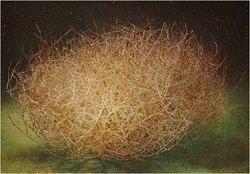 Albuquerque at Sunset
Albuquerque at Sunset Christmas in New Mexico

The tradition of Las Posadas dates back to the 16th century and St. Ignatius Loyola, who used an Aztec festival to teach about the birth of Christ, turning their nine-day celebration of the birth of the Aztec Sun God into a Christian celebration. What started as a novena, or nine days of prayer, eventually moved from the church to the community, to be celebrated in people's homes.
Typically, each family in a village or a neighborhood will schedule a night for the Posada to be held at their home. Every home has a nativity scene and the hosts of the Posada act as the innkeeper. The neighborhood children and adults are the pilgrims (peregrinos), who have to request lodging by going house-to-house singing a traditional song about the pilgrims. All the pilgrims carry small lit candles, or farolitos, in their hands. Two children portray Joseph and Mary. In many cases, Mary rides a small donkey (or burro) and Joseph leads it. Attendants such as angels and shepherds are acquired along the way, and walk along behind Mary and Joseph. The head of the procession will have a candle inside a paper lampshade. At each house, the resident responds by refusing lodging (also in song), until the weary travelers reach the designated site for the party, where Mary and Joseph are finally recognized and allowed to enter. At the end of the long journey, there will be Christmas carols (villancicos), and children will break open piñatas by striking these colorful papier-mâché objects with bats while blindfolded to break them open and obtain the candy hidden inside. Afterward comes the holiday feasting.
 The Las Posadas procession from St. Francis de Assisi Cathedral
The Las Posadas procession from St. Francis de Assisi Cathedral 
On Christmas Eve, as darkness fell at my home in Albuquerque, the luminarias were set alight to burn all night long. My father built a massive adobe fireplace, centered against the longest wall in the family room. A popping, flickering piñon fire cast its warm fragrant scent into the air. The blue spruce Christmas tree, my dad cut in the high country of northern New Mexico was decorated with black or brown-centered ojos de dios—the eyes of God—to watch over our home and family. Small kachinas, made from bits of felt and stuffed with cotton, hung from the trees as did the odds and ends made by my brothers and me over the years, in school, Cub Scouts and Girl Scouts. Mother also decorated the tree with iced sugar cookies, tied up in cellophane with colorful ribbon, and candy canes. It was an eclectic sort of tree, a tree celebrating children, but it was…beautiful...magical. Later on, after all of us were grown, mother decorated native plants to use as their Christmas tree. An artist, each tree Mother decorated was original, unique and remembered now only in pictures by a grateful daughter who treasured them and the memories she helped create.
 Tumbleweed...in case you wondered.
Tumbleweed...in case you wondered. 
I’ll be home for Christmas, Mom, if only in my dreams…